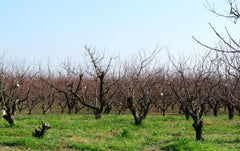Over the years, here at Frog Hollow Farm, we have used cover crops from time to time for various reasons with varying degrees of success.

Simply put, “cover crops” are plants grown on farms to cover the ground, as opposed to plants which are grown for food. There are literally hundreds if not thousands of plant species which are used as cover crops, and over the past 100 years or so they've all been extensively researched by universities across the nation to discover their benefits.
The list of benefits goes on and on. However, choosing the right mix of cover crops is a whole science unto itself, and requires careful management on the part of the farmer and his crews. And like everything in agriculture, the weather will play a powerful role in the desired outcome.
In recent years we've practiced the “laissez-faire” cover crop strategy which is the easy way - just let grow whatever grows - at Frog Hollow Farm. We call it "volunteer" cover crop. But this year, we're planning to intensify our use of cover crops because we now have access to very important resources: Dr. Gordon Franke of U. C. Berkeley and Christophe Kreis, our compost-meister.


